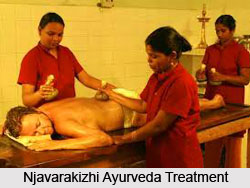 Njavarakizhi treatment is associated with the neuromuscular disorders and degenerative muscle diseases. This treatment will give benefit to the patients who are suffering from spondylosis, osteoarthritis, diabetic neuropathy, inter vertebral disc prolapse, rheumatoid arthritis.
Njavarakizhi treatment is associated with the neuromuscular disorders and degenerative muscle diseases. This treatment will give benefit to the patients who are suffering from spondylosis, osteoarthritis, diabetic neuropathy, inter vertebral disc prolapse, rheumatoid arthritis.
Njavarakizhi treatment is also an exceptional rejuvenating therapy to keep the body young and healthy. Njavarakizhi treatment nourishes the muscles, improves their tone, and imparts longevity.
Derivation of Njavarakizhi
Njavarakizhi treatment is also known as Shashtikashali Pinda Swedam. Njavarakizhi treatment in Malayalam stands for the rice, Shashtika Shali in Sanskrit language that grows in 60 days.
Kizhi (Pinda in Sanskrit) stands for bolus. Njavara is indigenous variety of rice grown in Kerala, having medicinal properties. Njavarakizhi treatment is a unique treatment procedure practiced by physicians of Ayurveda of Kerala.
Process of Njavarakizhi
The person in Njavarakizhi treatment is first preconditioned by applying mild oil on the body and head, and is made to lie down relaxingly. Warm "Njavara" rice, cooked with herbal decoction and milk, is squeezed out through a cotton pouch and massaged on to the whole body of the person. This continues for about 30 to 40 minutes until the whole preparation is evenly spread on the body. As soon as the rice spread looses its warmth, it is completely wiped off and warm oil is applied on the body. The person lies idle for another 30 minutes before he goes for a warm refreshing shower.
In the meantime, the steamed rice and herb mixture infuse their properties into the body tissues and nourish them. This revitalizes the deficient areas of the body, reduces its degeneration, and stops muscle wastage. And as a result of extended treatments of 2 to 3 weeks the body recoups its lost vitality.
The medicines like Lehyam (semi solid) and Kashayam (decoction) to be taken along with the treatment will give much more effective results in Njavarakizhi treatment. Other than the nourishing rice "Njavara", vetiver, ghee, ginger oil, milk, and herbs like sida, deodar and mustard are also used in making the decoction and preparation of Njavarakizhi treatment.
How to do Njavarakizhi
Njavarakizhi treatment is a modus operandi by which the whole body or any specific part is made to perspire , by the application of certain medicinal drugs with Njavara rice puddings externally in the form of boluses tied up in a muslin bag.
A generous amount of medicated oil is applied over the head and body. Then the body is massaged with warm muslin bag bolus containing njavara rice puddings cooked in the herbal decoction.
The boluses are dipped in the combination of warm milk and herbal decoctions when they cool down thus inducing sudation. The procedure is done in seven different postures.
At the end of the procedure, the Njavara rice paste sticking over the body is removed using coconut leaves. A gentle massage is given with warm medicated oil once again. The person is made to rest for 30 minutes.
Remedies of Njavarakizhi
By doing Njavarakizhi treatment one can find certain remedies like the removal of stiffness, reduces the stress, the slowing of ageing process. It helps in making the mind calm and promotes sound sleep. It also boosts immune system, enhances body nourishment and rejuvenates, improves lustre and texture of the skin, sharpens the sense organs of the human body and also it pacifies Vata Dosha and strengthens and nourishes the nervous system. Njavarakizhi treatment is also effective on blood borne diseases, plasticity, reduced mobility, rigidity, low back ache, Sciatica, scoliosis, kyphosis, perthe"s disease, cervical myelopathy, hemiplegia, arthritis and the muscle dystrophy and emaciation.




















